Different Types of Sunflower Varieties & Species for Your Garden
From the fluffy charm of ‘Teddy Bear Sunflowers’ to the towering majesty of ‘Giant Sungold’, and the vibrant hues of ‘Autumn Beauty’ and ‘Velvet Queen’, explore the diverse world of sunflower varieties.”
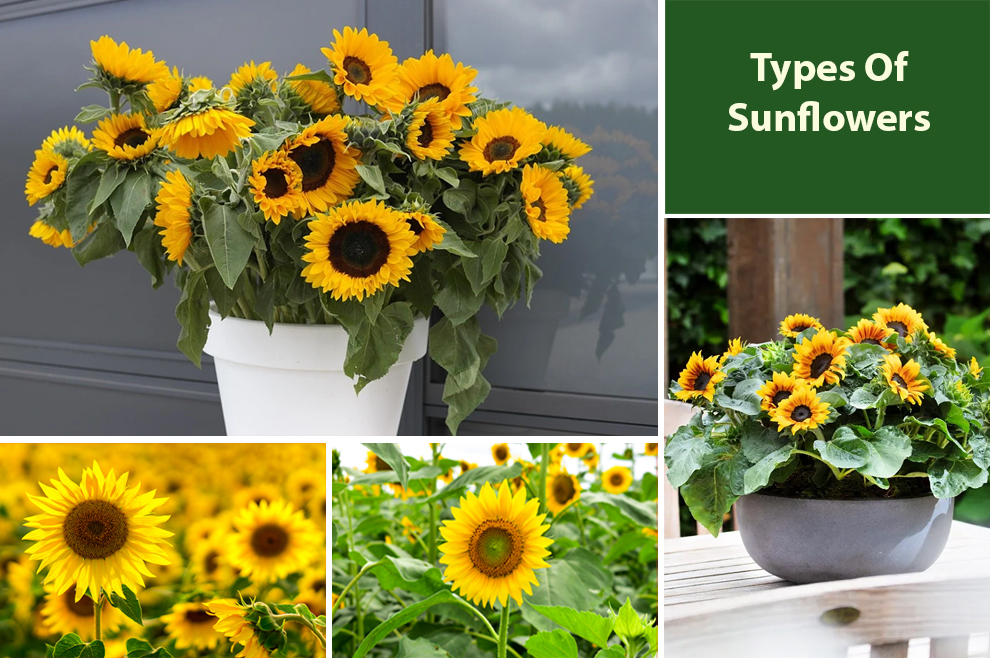
Sunflowers are known for their vibrant, large yellow blooms that look like the sun. Native to the South and North America, you will find different types of sunflowers growing across the world.
Sunflowers are popular ornamental plants. They are cultivated for their seeds, oil, or their seeds are even eaten raw/roasted in several recipes.
You can find sunflowers with varying sizes, shapes, and colors. Some sunflowers are slender and tall, while most are bushy and short. Some have single blooms, whereas others have several blooms per stem.
Of the different varieties of sunflowers, a few of the most prevalent ones include the Teddy Bear sunflower, Giant Sungold, the Lemon Queen, and the Autumn Beauty sunflower.
Overall, you can find over seventy kinds of sunflowers, with countless cultivators and varieties to pick from. We will discuss the popular ones along with their needed care (sun, soil, fertilizer, watering needs).
Different Kinds Of Sunflowers
- Dwarf Sunflower Varieties
- Tall Sunflower Varieties
- Branching Sunflower Varieties
- Ornamental Sunflower Varieties
- Types Of Sunflower With Seeds To Eat
- Multi-Headed Sunflower Varieties
- Rare Types Of Sunflowers
Sunflowers are a diverse group of plants, with countless varieties and cultivars available to choose from.
In this response, we have categorized sunflowers into seven types based on their height, branching habit, ornamental value, and more.
1. Dwarf Sunflower Varieties
Short sunflower varieties or dwarf sunflowers are an excellent pick for those who wish to grow sunflowers in containers or desire smaller plants in their flower beds.
Despite their size, some dwarf sunflower cultivars produce large flower heads on their stems about 12 to 36 inches tall, whereas others have smaller blooms.
A. Sundance Kid Sunflower
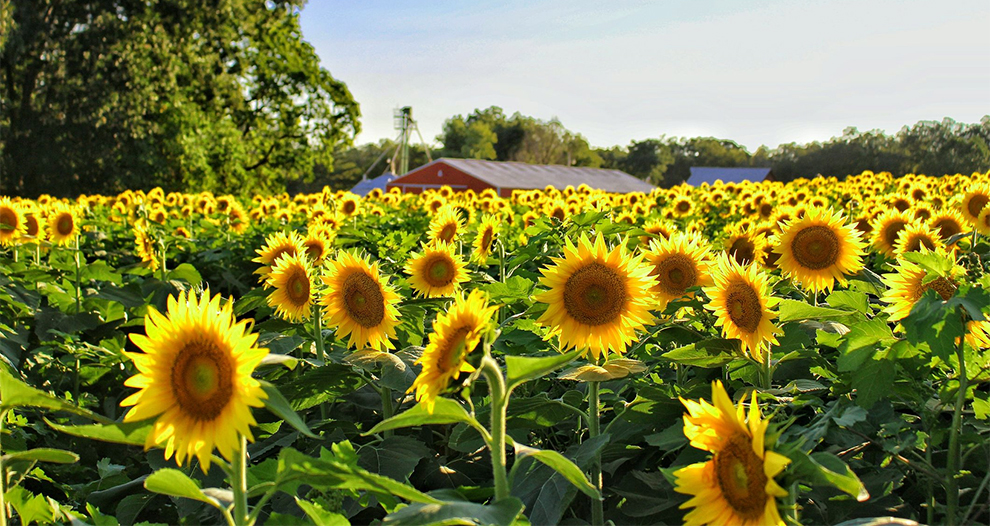
| Scientific name | Helianthus annuus ‘Sundance Kid’ |
| Flower color | Vibrant yellow with petals that fade from red to yellow. |
| Sunlight/Soil/Water | Full sunlight, well-draining soil, and regular watering may compete with other plants for moisture, so leave ample space between other plants to avoid water depletion. |
| Mostly found in | North America |
| Height | Up to 2 feet tall |
| Growth season | Summer and fall |
Sundance Kid Sunflowers are one of the spectacular types of sunflower plants. They are one of the oldest dwarf sunflowers and can add color to any landscape or garden.
These sunflowers are known for their semi-double leaves that are yellow and red, with a small brown disc in the center. It is an easy-to-grow variety that blooms early and has a longer flowering period than other sunflowers.
B. Sunny Smile Sunflower
| Scientific name | Helianthus annuus |
| Flower color | Bright yellow petals with dark brown centers |
| Sunlight/Soil/Water | Full sun, well-drained soil, regular watering |
| Mostly found in | North America |
| Height | 12-15 inches |
| Growth season | Year-round, blooms best in early to late summer |
Sunny Smile is an attractive dwarf sunflower variety ideal for porches, patios, and indoor spaces. It blooms across the year and is pollen-free, making it an attractive pick for individuals with allergies.
These miniature sunflowers grow up to 15 inches tall with sturdy stalks and bright yellow petals with dark brown centers. They thrive in full sunlight and grow best in early to late summer.
If you need a variety that blooms across the year, Sunny Smile should be your go-to pick.
C. Suntastic Yellow Sunflower
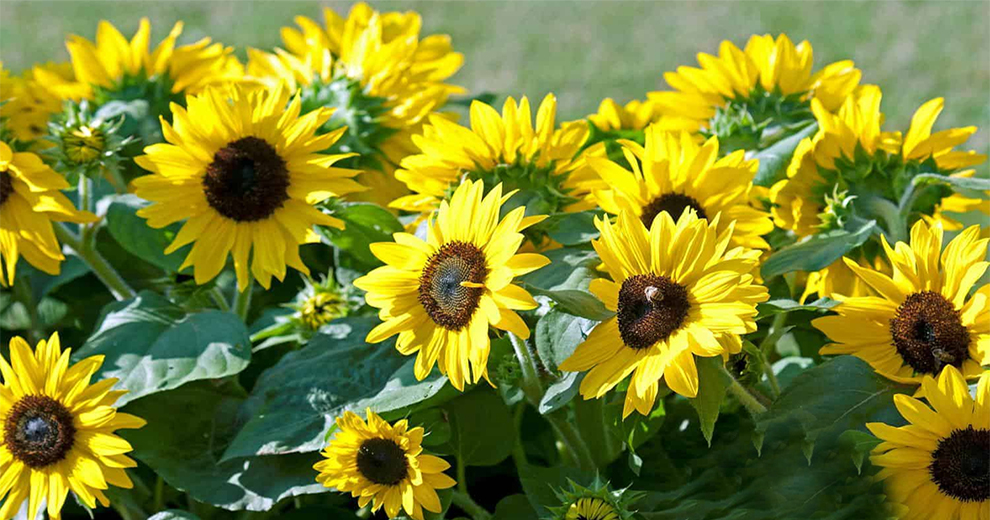
| Scientific name | Helianthus annuus |
| Flower color | Golden yellow with black centers |
| Sunlight/Soil/Water | Full sun, moist and well-draining soil |
| Mostly found in | North America |
| Height | 12-24 inches tall, 8-10 inches wide |
| Growth season | Annual |
Suntastic Yellow Sunflowers is a 2014 All-American Selection Winner. These are amongst the different species of sunflowers that bloom up to three times yearly with twenty blooms per plant.
These dwarf varieties grow up to 20 inches in height and yield yellow flowers with black centers about six inches across in only 65 days of plating.
These are pollen-free. So, you can choose this variety if you suffer from allergies. Further, these plants have multiple stems emerging from their strong stalk and producing several flower heads on every stem.
2. Tall Sunflower Varieties
You will find multiple types of sunflower plants under this category. They grow extremely tall, and some varieties reach up to 15 feet. The tallest sunflower ever recorded stood at an incredible height of 30 feet and 1 inch.
A. Mongolian Giant Sunflower
| Scientific name | Helianthus annuus |
| Flower color | Yellow |
| Sunlight/Soil/Water | Full Sun/Well-drained soil/Regular watering |
| Mostly found in | North America, Central America |
| Height | 12 to 14 feet |
| Growth season | Summer/Fall |
The Mongolian Giant sunflower variety appeals to people because of its large size. Every plant yields a single flower head about 14 to 18 inches in diameter.
These sunflower varieties take about 90 days to bloom, and the yellow flower heads last for about four to six weeks before producing giant seed heads.
To grow Mongolian Giant Sunflowers, please ensure you have ample space and time to care for them.
Growing these sunflower cultivars can be a fun activity for the kids as these grow rapidly during the peak growing season. You can plant them along a fence to build a fantastic play area for the children.
B. Evening Sun Sunflower
| Scientific name | Helianthus annuus ‘Evening Sun |
| Flower color | Orange, Red |
| Sunlight/Soil/Water | Full sun, well-draining soil, moderate water |
| Mostly found in | U.S., Central America |
| Height | 6-8 feet tall, 2-3 feet wide |
| Growth season | Summer through fall |
The Evening Sun can be a good option when you need a different sunflower variety. It has a beautiful orange and red flower head. This variety has a branching growth habit with several stems and flowers on each plant. It blooms from summer through fall, and its flowers last two weeks in the vase.
Beyond its unique coloration, Evening Sun also yields flowers of gold, crimson, and blends. These tall plants are attractive to goldfinches in late summer. The plant grows best in hardiness zones two through eleven.
C. Candy Mountain Sunflower
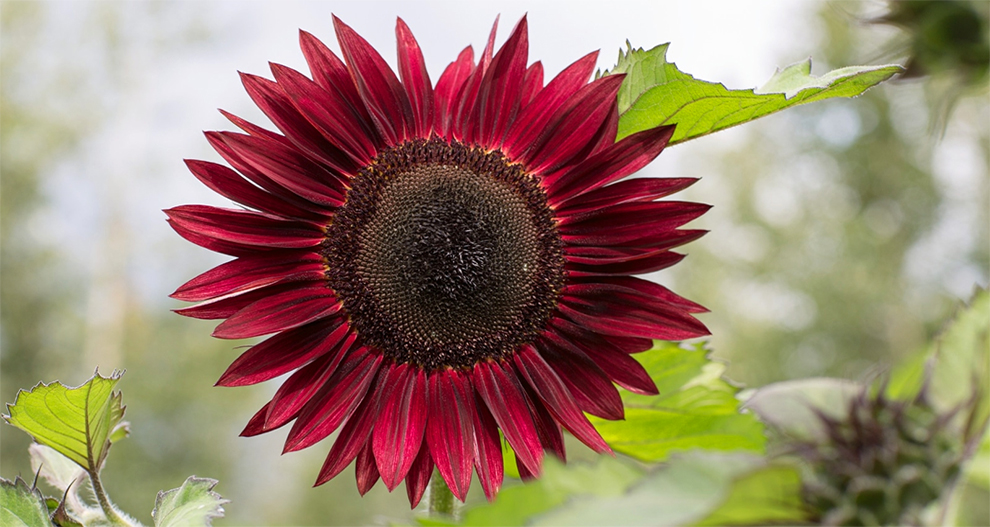
| Scientific name | Digitalis purpurea |
| Flower color | Yellow and Red |
| Sunlight/Soil/Water | Full sun; well-drained soil; regular watering |
| Mostly found in | South-central Utah |
| Height | 8-10 feet tall, 2-3 feet wide |
| Growth season | Summer through fall |
The branching Candy Mountain Sunflower is a stunning variety with red and yellow flowers that give off a fame-like appearance.
Its center is brown, and every bloom is adorned with numerous flowers, as each branch forms its collection.
Even though it is a tall plant, Candy Mountain is suitable for smaller gardens as a single plant will produce many blossoms.
3. Branching Sunflower Varieties
In this category, several different kinds of sunflowers branch out and produce multiple blooms, making them excellent for flower borders and beds. Some of them are classic heirloom varieties, whereas others are newer hybrids.
A. Gypsy Charmer Sunflower
| Scientific name | Helianthus annuus ‘Gypsy Charmer’ |
| Flower color | Lemon yellow, golden yellow, and shades of rose |
| Sunlight/Soil/Water | Full Sun, Moderately fertile, humus-rich, moist, neutral to alkaline, well-drained soil, Average water needs. |
| Mostly found in | North America, particularly in regions with warm, sunny summers and moderate rainfall |
| Height | 4-6 feet tall, 1-2 feet wide |
| Growth season | Summer, mid-late |
The Gypsy Charmer sunflower is a gorgeous bicolored variety with pink and yellow flowers with a diameter of eight inches. These have a beautiful branching habit, and each branch has flowers of its own that form a spectacular profusion of colors.
This sunflower is perfect for a cutting garden and a sunny garden’s backdrop. They grow best in hardiness zones two through eleven.
B. Autumn Beauty Sunflower
| Scientific name | Helianthus annuus |
| Flower color | Yellow, red, orange, and bronze |
| Sunlight/Soil/Water | Full sun, well-drained soil, dry moderate water requirements |
| Mostly found in | North America |
| Height | 5 to 7 feet |
| Growth season | Summer to fall |
From the different varieties of sunflowers, Autumn Beauty is known for its varied and colorful blooms. This sunflower variety yields multi-branch, large heads with multi-hued flowers.
These flowers attract butterflies, bees, and other pollinators, making them a spectacular choice for gardeners hoping to support local wildlife.
Autumn Beauty is predominantly grown for use in cut flower arrangements, as the blooms usually last up to two weeks in a vase.
C. Pacino Sunflower
| Scientific name | Helianthus annuus |
| Flower color | Yellow |
| Sunlight/Soil/Water | Full sun, |
| Mostly found in | North America |
| Height | 14” tall, 11” wide |
Those interested in growing different kinds of sunflowers that branch out will also cherish having Pacino in their garden. It is a beautiful plant with bright yellow leaves and a small disc at the center of every flower head.
Its strong stalk can support multiple flower heads, giving containers or gardens a thriving appearance. You can find two different varieties in Pacino – Pacino Gold with all-yellow petals and disc, and the Pacino Cola with yellow petals and a dark center.
To achieve a natural-looking container garden or flower bed, you must plant both these types of sunflower plants together in a random arrangement.
4. Ornamental Sunflower Varieties
These sunflowers are beautiful and useful plants grown for ornamental purposes. Several varieties of ornamental sunflowers are popular as flowering plants. Below we will enlist three of them.
A. Russian Mammoth Sunflower
| Scientific name | Helianthus annuus ‘Russian Mammoth’ |
| Flower color | Bright yellow petals and a chocolate brown center |
| Sunlight/Soil/Water | Full sun, neutral to alkaline, moderately fertile soils |
| Mostly found in | Mediterranean climate |
| Height | 9-12 feet |
| Growth season | Late summer |
Also known as the Common Sunflower, Russian Mammoth is a low-maintenance sunflower that produces 14-inch wide flowers. They look strikingly appealing when planted around the base with different colors and types of celosia.
It is easy to care for sunflowers, but you must grow them in a sheltered space because their heavy flowerbeds tend to break off in the wind. These sunflowers attract birds, butterflies, and bees, increasing pollination.
Moreover, squirrels and birds love snacking on their edible seeds, which can be harvested and roasted for human consumption.
B. Teddy Bear Sunflower
| Scientific name | Helianthus annuus ‘Teddy Bear’ |
| Flower color | Yellow |
| Sunlight/Soil/Water | Full Sun
Soil rich in organic matter, loose in texture, and has good drainage capacity. Moderate watering |
| Mostly found in | North America |
| Height | Two to Four feet Tall and Five to Six inches across |
| Growth season | Mid-summer |
Lauded with the Award of Garden Merit from the Royal Horticultural Society in 2015, Teddy Bear is a dwarf version of the Giant Sungold with fluffy, double-layered petals.
Amongst the different varieties of sunflowers, Teddy Bear stands out for its edible seeds and petals. The fluffy and soft petals are predominantly used as garnishes for cakes and salads, making the sunflower an economical choice.
Beyond its edible properties, the Teddy Bear sunflower attracts birds and bees. It has a growth period of 75 days and continues to bloom for about five weeks. Its fluffy petals give them a cloudy and charming appearance.
Hence, they are a spectacular space-saving choice because of their tiny size.
C. Lemon Queen Sunflower
| Scientific name | Helianthus annuus ‘Lemon Queen’ |
| Flower color | Lemony petals and deep brown centers |
| Sunlight/Soil/Water | Full sun, rich soil, and moderate moisture |
| Mostly found in | USDA Hardiness Zones 2 to 11. |
| Height | Five to seven feet |
| Growth season | Summer to fall |
It is a favorite amongst flower gardeners from the different species of sunflowers. Lemon Queen is one of the easy-to-grow, tall, and fast-growing heirloom varieties that yield lemon-yellow petals with a chocolate brown center.
It is extra appealing to pollinators. Hence it is one of the top sunflowers to attract bees and other beneficial pollinators.
Lemon Queen primarily produces one main bloom on the center stalk, and small flowers show on its side shoots. It continues to flower until the first frost hits. This sunflower has edible buds.
So, you can harvest them earlier, but the plant will mature in 100 days. So, patience is needed. You can directly sow the seeds in spring or begin indoors a few weeks prior.
Consider successive plantings every one to two weeks for a long bloom time. It’s a great idea to plant ‘Lemon Queen’ with darker-colored perennials or annual flowers for a great accent.
5.Types Of Sunflower Seeds To Eat
Seeds from any open-pollinated H. annuus can be consumed by birds and humans. However, certain home garden varieties are highly sought after due to their abundance of fleshy seeds.
These include both traditional heirloom plants that grow over a foot in size and newer sunflower cultivars.
These varieties are also known for their deliciousness, to the extent that one may need to compete with squirrels for the harvest.
A. Mammoth Grey Stripe Sunflower
| Scientific name | Helianthus annuus ‘Mammoth Grey Stripe’ |
| Flower color | Bright yellow petals and a deep brown center |
| Sunlight/Soil/Water | Full sun, well-drained soil, moderate watering |
| Mostly found in | USDA hardiness 2 through 11 |
| Height | 9-12 feet tall and 3-4 feet wide |
| Growth season | Late spring to early fall |
Mammoth Grey is an annual plant that eventually gets loaded with seeds. It is a favorite amongst bees and other pollinators because of its open-pollinated nature and large size.
It is best to plant them in the back of a border as a primary screen or in a cutting garden. But they require support from bamboo stakes or fences and must be spaced at least three feet apart.
Typically, the plant takes 100 to 110 days from sowing to blowing. Thus, plan accordingly. The flowers stay intact for over a month before harvesting, and each flower can yield over 100 seeds.
Cover the mature heads with netting to prevent squirrels or birds from eating them. These sunflowers are deer-resistant and a great addition to any garden.
B. Mongolian Giant Sunflower
| Scientific name | Helianthus annuus uniflorus |
| Flower color | Yellow |
| Sunlight/Soil/Water | Full sun and rich, moderately moist soil, and frequent watering |
| Mostly found in | USDA zones 9 and 10 but are the happiest in the warm season |
| Height | 12 to 14 feet |
| Growth season | Summer to fall |
Apart from being famous for their size as mentioned above, these are also famous for their seed consumption.
C. Super Snack Sunflower
| Scientific name | Helianthus annuus ‘Super Snack’ |
| Flower color | Varies, typically yellow with dark centers |
| Sunlight/Soil/Water | Full sun, well-drained soil, regular watering |
| Mostly found in | USDA hardiness zones three through nine |
| Height | Five feet |
| Growth season | Spring & Fall |
Do you wish to cherish a harvest of homegrown seeds without dealing with the gargantuan stalks? If yes, Super Snack could be the right pick. Among the different types of sunflowers, this sunflower hybrid takes around 60-70 days to flower and has 10-inch blooms that look like the Mongolian Giant flowers.
Each stem yields one flower that can produce approximately one pound of meaty kernels. Its ripe seeds are ready for harvest about a month to six weeks after the plants bloom. Beyond being an excellent food source, this variety works well as a cut flower and functions as a privacy screen.
It gets its name from plentiful, large, and easy-to-crack seeds that birds and humans enjoy. They have loosely arranged petals that terminate at a point and attract pollinating insects such as bees and butterflies.
6. Multi-Headed Sunflower Varieties
Multi-headed sunflower varieties produce more than one flower per stem or branch. It is in contrast to traditional sunflowers that have a single bloom per stem.
These include:
- Lemon Queen
- Autumn Beauty
- Pacino
These are the different kinds of sunflowers that we have already discussed above.
7. Rare Types Of Sunflowers
Rare sunflowers are not commonly found or cultivated and may have unique characteristics, colors, or growth patterns that set them apart from more common varieties.
These may include heirloom varieties passed down for generations, wild varieties native to specific regions, or hybrids developed through specialized breeding programs.
A. Schweinitz’s Sunflowers
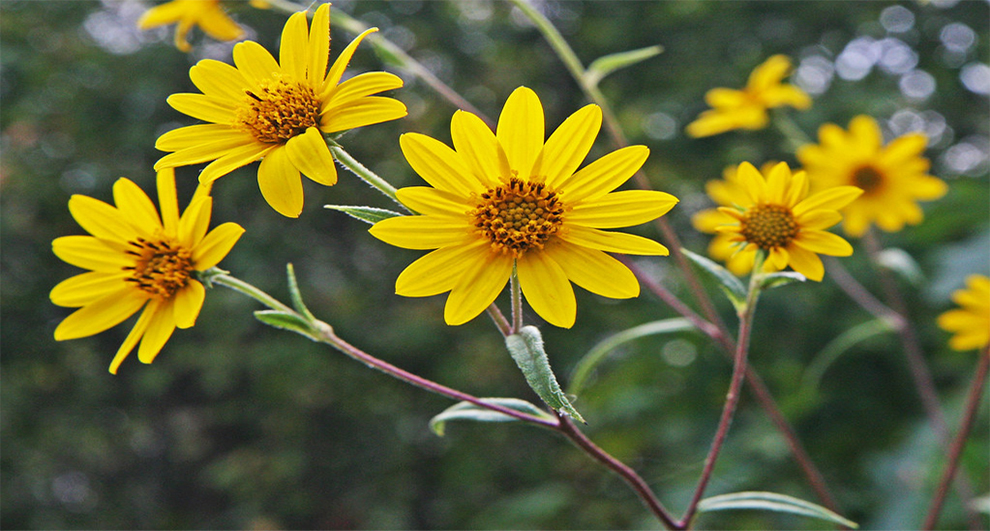
It is one of the rarest species in America and is christened after the botanist Lewis David von Schweintz, who discovered the species in the early 1880s.
| Scientific name | Helianthus schweinitzii |
| Flower color | Yellow with a dark center |
| Sunlight/Soil/Water | Full sun, well-drained soil, and moderate water |
| Mostly found in | America |
| Height | 6.5 feet to 16 feet tall |
| Growth season | Summer |
B. Neglected Sunflower
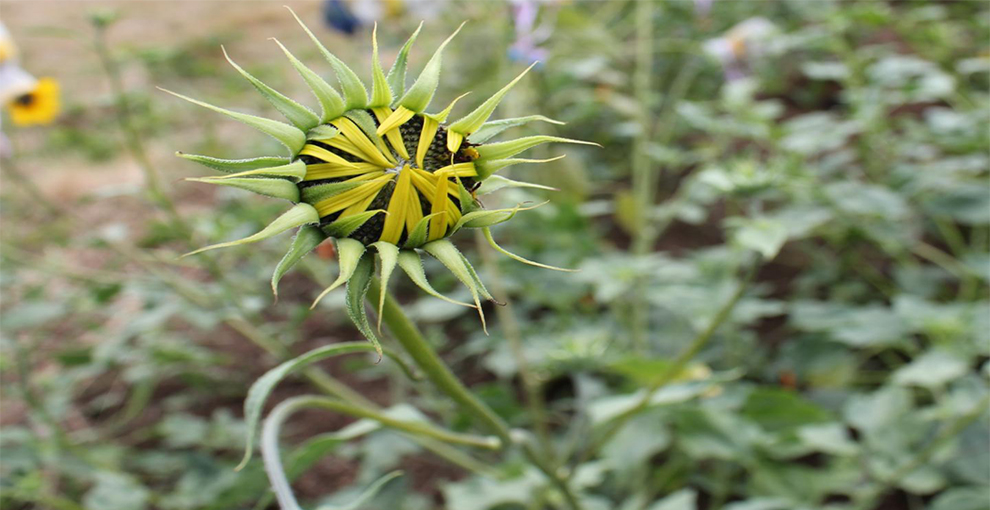
It is a relatively rare sunflower that thrives on the sandy hillsides in New Mexico and Texas.
| Scientific name | Helianthus neglectus “Neglected Sunflower“ |
| Flower color | Yellow with dark center |
| Sunlight/Soil/Water | Full sun, extremely sandy soil, and moderate water |
| Mostly found in | 8 through 11 |
| Height | 3 to 6 feet |
| Growth season | Summer |
C. Italian White
| Scientific name | Helianthus annuus Italian White |
| Flower color | Creamy blooms with dark centers |
| Sunlight/Soil/Water | Full sun, neutral to alkaline soil, and moderate water |
| Mostly found in | Two through Eleven |
| Height | Five feet |
| Growth season | US and Central America |
This sunflower variety is a robust and branching plant that produces a profusion of flowers that look like an Italian cream cake. The upright stalks of these old-fashioned varieties grow to 48 to 60 inches and bloom between 90 and 110 days.
Once they burst forth with their beautiful bunches of four-inch, daisy-like flowers, the wait will seem worth it as they continue blooming for a month or more.
Cut the stems often for floral arrangements and to encourage more blossoms. Of the different types of sunflowers in this category, these are popular among butterflies and bees.
Related: How to grow sunflowers | Lifespan of sunflowers | Best fertilizer for sunflowers
Do purple sunflowers exist?
Yes, purple sunflowers exist. Though these are rare but there do exist some sunflowers that produce dark cherry purple flowers.
Which sunflower blooms the longest?
Several sunflowers can bloom for a long time, but the Sunflower Sunfinity, Italian White, and Lemon Queen varieties are known to have a particularly long bloom time.
How many different colors of sunflowers are there?
Technically only three primary colors of different types of sunflowers exist: yellow, red, and brown. However, many hybrid varieties have been developed over time, resulting in several colors, including shades of orange, burgundy, bronze, purple, blue, and even bi-colors.
Quick Recap:
- Tallest sunflower variety: Russian Giant or Mammoth Giant sunflower
- Largest sunflower variety: Giant Sunflowers
- Hybrid varieties of sunflower: Moulin Rouge, Strawberry Blonde, Italian White, Lemon Queen, Dwarf Sungold, etc
- Perennial sunflower plants: Jerusalem artichoke, Maximilian sunflower, False sunflower, Sawtooth sunflower, etc.
